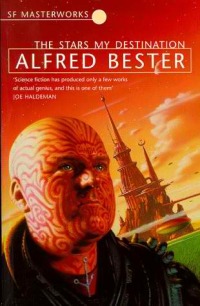The Stars My Destination by Alfred Bester
 Sunday, October 28, 2012 at 8:43PM
Sunday, October 28, 2012 at 8:43PM 
First published in 1956
There are more ideas in The Stars My Destination -- profound ideas about human potential -- than you're likely to find collectively in the next dozen novels you read. The Stars My Destination begins as a tale of obsession and vengeance. The protagonist is an anti-hero, not the sort of person for whom a reader would normally root, but he is sympathetic compared to most of the novel's other characters, including a powerful corporate executive who makes Gordon Gecko seem like a mischievous boy. In Alfred Bester's future, people have acquired the ability to teleport over long distances, the colonized planets are at war with each other, and cities are filled with people who belong in carnival sideshows. But that's all window dressing for Bester's deeper exploration of a man who is "nothing but hatred and revenge," an Ahab of the twenty-fourth century chasing his own version of a white whale, a spaceship called Vorga. Ultimately, The Stars My Destination is a novel about the limits of idealism, the meaning of justice, the nature of power, and the transcendental ability of the human species to overcome its self-imposed limitations.
Gulliver Foyle, a common man who lacks ambition, a brute raised in the gutter school and "among the least valuable alive," is a crew member on the Nomad when it is attacked during the war between the inner and outer (colonized) planets of Earth's solar system. Foyle, the only member of the Nomad to survive, lives for months in an airtight tool locker not much bigger than a coffin. On his way to madness, he becomes obsessed with a rhyme that ends: "Deep space is my dwelling place/And death's my destination." When a ship called the Vorga ignores his distress signal, Foyle makes it his mission to repair the Nomad's engines so he can track down and destroy the Vorga. He manages to get himself to the asteroid belt (populated by descendants of stranded scientists who tattoo a grotesque tiger-design on Foyle's face) before he makes his way back to Earth. Once there, however, he's captured by employees of Presteign, CEO of the company that owns the Vorga. Presteign wants to know where to find the Nomad and its valuable cargo, a weapon that could shift the balance of power in the interstellar war. Foyle's captivity brings him into contact with Jisbella McQueen, with whom he falls in love -- but love is a small emotion compared his consuming hatred of the Vorga. He later falls in love with Presteign's daughter Olivia, who sees the world in infrared. But love is a cruel emotion, particularly when it clouds the overwhelming desire for vengeance.
New and strange twists appear regularly as the story progresses. Foyle creates the ability to move at accelerated speed. An entity called The Burning Man pops up from time to time, a fiery creature who looks like Foyle. While Foyle wonders if The Burning Man is his guardian angel, a more creative and satisfying explanation for the entity eventually comes to light. After a series of adventures that lead Foyle back to the Nomad, Foyle reinvents himself, becoming Fourmyle of Ceres, an illusionist and circus master whose clout matches Presteign's own. Foyle uses and abuses telepaths in his attempt to track down the person who ordered the Vorga to ignore the Nomad's distress call. The truth, when he finally learns it, shocks him.
Bester gives the uneducated Foyle a unique dialect that is a joy to read. Bester's vivid prose is well-suited to the story, but the novel was ahead of its time in its unconventional use of font placement, creating pictures with fonts to emphasize the confusion that besets Foyle's mind.
The Stars My Destination is a seminal work of science fiction that succeeds on a number of levels. It is a rollicking adventure story and an imaginative tale of the future, but it is more fundamentally a psychological exploration of a troubled soul in need of redemption. It is a cautionary tale about the arrogance of leadership and the virtue of restoring power to the people. Finally, it is a touching story about acceptance and self-determination and the possibility of achieving greatness. To achieve his ends, Gully Foyle must remake himself, and that is where the novel's genius lies. Foyle is no Ahab, incapable of change, consumed by a hatred that will eventually destroy him. Foyle's obsession motivates him to acquire knowledge and strength to serve his need for vengeance, but once he has those new resources, he begins to see the world anew -- as does the reader. Foyle recognizes that he is a freak, but so what? "Life is a freak. That's its hope and glory." We're all freaks, but we all have the ability to become something glorious.
HIGHLY RECOMMENDED
 TChris |
TChris |  Post a Comment |
Post a Comment |  Alfred Bester,
Alfred Bester,  HR in
HR in  Science Fiction
Science Fiction